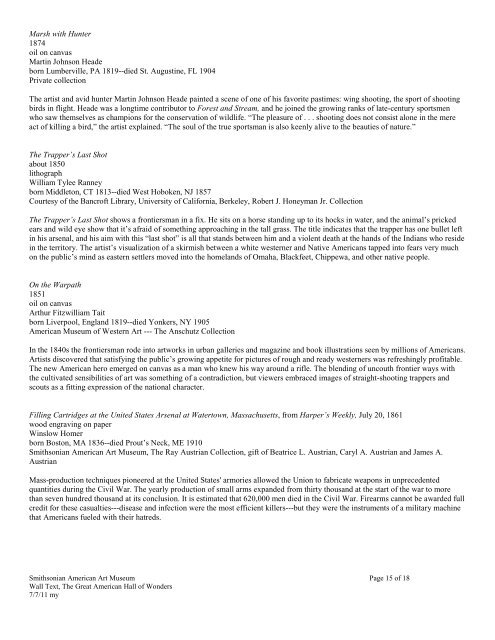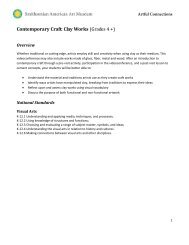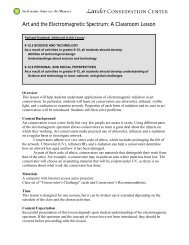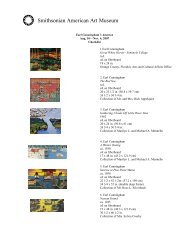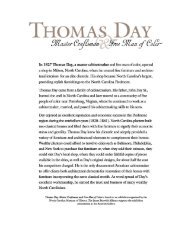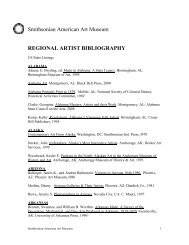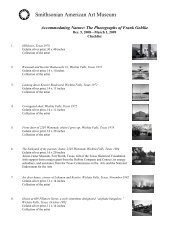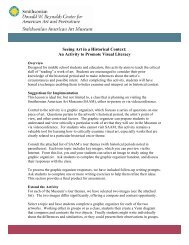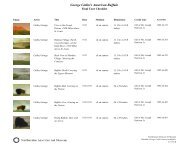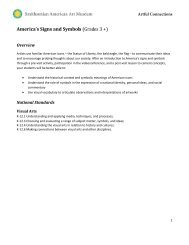Smithsonian American Art Museum - Smithsonian Institution
Smithsonian American Art Museum - Smithsonian Institution
Smithsonian American Art Museum - Smithsonian Institution
Create successful ePaper yourself
Turn your PDF publications into a flip-book with our unique Google optimized e-Paper software.
Marsh with Hunter<br />
1874<br />
oil on canvas<br />
Martin Johnson Heade<br />
born Lumberville, PA 1819--died St. Augustine, FL 1904<br />
Private collection<br />
The artist and avid hunter Martin Johnson Heade painted a scene of one of his favorite pastimes: wing shooting, the sport of shooting<br />
birds in flight. Heade was a longtime contributor to Forest and Stream, and he joined the growing ranks of late-century sportsmen<br />
who saw themselves as champions for the conservation of wildlife. “The pleasure of . . . shooting does not consist alone in the mere<br />
act of killing a bird,” the artist explained. “The soul of the true sportsman is also keenly alive to the beauties of nature.”<br />
The Trapper’s Last Shot<br />
about 1850<br />
lithograph<br />
William Tylee Ranney<br />
born Middleton, CT 1813--died West Hoboken, NJ 1857<br />
Courtesy of the Bancroft Library, University of California, Berkeley, Robert J. Honeyman Jr. Collection<br />
The Trapper’s Last Shot shows a frontiersman in a fix. He sits on a horse standing up to its hocks in water, and the animal’s pricked<br />
ears and wild eye show that it’s afraid of something approaching in the tall grass. The title indicates that the trapper has one bullet left<br />
in his arsenal, and his aim with this “last shot” is all that stands between him and a violent death at the hands of the Indians who reside<br />
in the territory. The artist’s visualization of a skirmish between a white westerner and Native <strong>American</strong>s tapped into fears very much<br />
on the public’s mind as eastern settlers moved into the homelands of Omaha, Blackfeet, Chippewa, and other native people.<br />
On the Warpath<br />
1851<br />
oil on canvas<br />
<strong>Art</strong>hur Fitzwilliam Tait<br />
born Liverpool, England 1819--died Yonkers, NY 1905<br />
<strong>American</strong> <strong>Museum</strong> of Western <strong>Art</strong> --- The Anschutz Collection<br />
In the 1840s the frontiersman rode into artworks in urban galleries and magazine and book illustrations seen by millions of <strong>American</strong>s.<br />
<strong>Art</strong>ists discovered that satisfying the public’s growing appetite for pictures of rough and ready westerners was refreshingly profitable.<br />
The new <strong>American</strong> hero emerged on canvas as a man who knew his way around a rifle. The blending of uncouth frontier ways with<br />
the cultivated sensibilities of art was something of a contradiction, but viewers embraced images of straight-shooting trappers and<br />
scouts as a fitting expression of the national character.<br />
Filling Cartridges at the United States Arsenal at Watertown, Massachusetts, from Harper’s Weekly, July 20, 1861<br />
wood engraving on paper<br />
Winslow Homer<br />
born Boston, MA 1836--died Prout’s Neck, ME 1910<br />
<strong>Smithsonian</strong> <strong>American</strong> <strong>Art</strong> <strong>Museum</strong>, The Ray Austrian Collection, gift of Beatrice L. Austrian, Caryl A. Austrian and James A.<br />
Austrian<br />
Mass-production techniques pioneered at the United States' armories allowed the Union to fabricate weapons in unprecedented<br />
quantities during the Civil War. The yearly production of small arms expanded from thirty thousand at the start of the war to more<br />
than seven hundred thousand at its conclusion. It is estimated that 620,000 men died in the Civil War. Firearms cannot be awarded full<br />
credit for these casualties---disease and infection were the most efficient killers---but they were the instruments of a military machine<br />
that <strong>American</strong>s fueled with their hatreds.<br />
<strong>Smithsonian</strong> <strong>American</strong> <strong>Art</strong> <strong>Museum</strong> Page 15 of 18<br />
Wall Text, The Great <strong>American</strong> Hall of Wonders<br />
7/7/11 my


